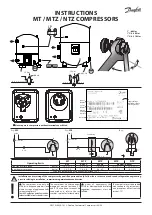
13–8–606 Page 36
FIGURE 5–9 – WATER CONTROL VALVE
heat exchanger oil cooler is a multiple pass type, with
water in the tubes and oil in the shell. The oil tempera-
ture is controlled by the thermal (thermostatic mixing)
valve. The optional water control valve may be used to
conserve water.
Oil cooler malfunction may be traced by checking pres-
sure at oil inlet and outlet. At normal operating air ser-
vice pressure (65 to 150 psig, 4.5 to 10.3 Bars) with the
unit warm, a pressure drop of 3 to 15 psi (.2 to 1 Bar)
can be expected between the oil inlet and the oil outlet.
Water pressure drop from water inlet to outlet will vary
with the inlet pressure and amount of water flowing. A
normal pressure drop may range from 5 to 10 psi (.3 to
.7 Bar). Any change in the pressure drop from that nor-
mally held may indicate tube leakage or fouling and
should be investigated.
In many instances, the cooling water supply for the heat
exchanger will contain impurities in solution and/or sus-
pension. These substances can cause scale forma-
tion, corrosion and plugging of any water–cooled heat
exchanger equipment. Disregarding the possibility that
one or more of these conditions exist may result in in-
creased maintenance and operation expense, reduced
equipment life and emergency shutdown. It is strongly
recommended that a reputable, local water treatment
concern be engaged to establish the corrosion, scale
forming and fouling tendency of the cooling water and
take steps necessary to remedy the situation if a prob-
lem does exist. The need for water treatment may in-
volve only filtration (screening) to remove debris, sand
and/or salt in the cooling water supply. However,
chemical treatment methods may be necessary in cer-
tain instances to inhibit corrosion and/or remove dis-
solved solids, to alter the water’s tendency to form
scale deposits, or prevent the growth of microorgan-
isms. The normal maintenance program for the unit
should also include periodic cleaning of the tubes (wa-
ter side) of the heat exchanger to remove deposits
which enhance fouling and corrosion.
Hex head zinc anodes are used in the return bonnet
(opposite end to the water pipe connections) of heat ex-
changers to provide internal water system corrosion
protection. These anodes should be inspected periodi-
cally and replaced when the zinc has been reduced to
about 1/2 inch (13mm) in length.
WATER FLOW CONTROL VALVE FOR HEAT EX-
CHANGER (Optional Equipment) (FIGURE 5–9) –
The water flow control valve is adjustable to compen-
sate for varying water inlet temperatures and pressur-
es and is to be mounted in the water outlet line after the
oil cooler (FIGURE 5–1, page 28). Use the compres-
sor discharge air temperature gauge on the instrument
panel in setting the flow control valve. The compressor
discharge temperature must be maintained a minimum
of 10
_
F (5
_
C) above the dew point temperature at the
maximum anticipated ambient; refer to FIGURE 5–10,
page 37, for the dew point temperature at the operating
pressure and ambient temperature of the application.
To decrease water flow (increase compressor dis-
charge air temperature) turn the adjusting screw from
left to right, increasing spring tension. To increase wa-
ter flow (decrease compressor discharge air tempera-
ture) turn the adjusting screw in the opposite direction.
The groove at the lower edge of the adjusting screw is
an index line for use with the index scale 0 to 8 in obtain-
ing a desired setting.
These valves must be handled with care and proper
tools and techniques must be used when working on
the valve.
Care must be used when handling the capillary tube; a
kink or break in the tubing or connections will make the
valve inoperative. Never attempt to change capillary
length. Excess capillary tube should be carefully coiled
and placed so that damage will not occur in normal
maintenance or traffic past the unit.
If the leak develops through the packing, tighten the
packing gland nut firmly with a wrench to reseat the
packing around the valve stem, then back off the nut
until loose, and finally retighten the nut finger tight.
Tightening the packing nut too tight may cause erratic
operation. An occasional drop of oil on the valve stem
at the packing nut will prolong packing life.
If valve malfunctions, check for bent or binding, paint
or corrosion on valve stem, foreign material in valve,
erosion, or thermal system (capillary) failure. If foreign
Summary of Contents for EDF-KB
Page 14: ...13 8 606 Page 6 DECALS 206EAQ077 212EAQ077 218EAQ077 211EAQ077 207EAQ077...
Page 15: ...13 8 606 Page 7 DECALS 216EAQ077 217EAQ077 222EAQ077 221EAQ077 208EAQ077...
Page 34: ...13 8 606 Page 26 FIGURE 4 10 WIRING DIAGRAM FULL VOLTAGE DUAL CONTROL 208EDF546 Ref Drawing...
Page 36: ...13 8 606 Page 28 FIGURE 5 1 FLOW DIAGRAM 204EDF797 Ref Drawing...
Page 58: ......















































